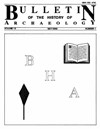The McKern Taxonomic System and Archaeological Culture Classification in the Midwestern United States: A History and Evaluation
DOI:
https://doi.org/10.5334/bha.06102Keywords:
Archaeological Culture Classification, McKern Taxonomic SystemAbstract
In the first half of the 20th century three major archaeological culture unit classifications were formulated in the United States. The most curious one was the Midwestern Taxonomic System, a scheme that ignored time and space. Alton K. Fisher suggested to W. C. McKern in the late 1920's that the Linnean model of morphological classification, which was employed in biology at a time of pre-evolutionary thinking, might be adapted to archaeological culture classification (Fisher 1986). On the basis of this idea McKern conceived the Midwestern Taxonomic System and planned to present his concept in a paper at the Central Section of the American Anthropological Association at Ann Arbor, Michigan, in April, 1932. Illness prevented him from making the presentation.The first public statement was before a small group of archaeologists at the time of an archaeological symposium, Illinois Academy of Science, May 1932 (Griffin 1943:327). After input from various archaeologists a formal account was prepared as a manuscript entitled "Culture Type Classification for Midwestern North American Archaeology" at the Chicago Conference, December 10, 1932. Other participants at this conference were Samuel A. Barrett, Fay Cooper Cole, Thorne Deuel, Carl E. Guthe, A. R. Kelly (Cole and Deuel 1937a:34) and James B. Griffin (as a graduate student, personal communication, 1986). This classification method was more fully and formally presented three years later, in December 1935, at the original Indianapolis Archaeological Conference (Guthe 1937). A more detailed history of the origins of the McKern system is provided by Griffin (1943).
Downloads
Published
Issue
Section
License
Copyright (c) 1996 The Author(s)

This work is licensed under a Creative Commons Attribution 4.0 International License.
Authors who publish with this journal agree to the following terms. If a submission is rejected or withdrawn prior to publication, all rights return to the author(s):
- Authors retain copyright and grant the journal right of first publication with the work simultaneously licensed under a Creative Commons Attribution License that allows others to share the work with an acknowledgement of the work's authorship and initial publication in this journal.
- Authors are able to enter into separate, additional contractual arrangements for the non-exclusive distribution of the journal's published version of the work (e.g., post it to an institutional repository or publish it in a book), with an acknowledgement of its initial publication in this journal.
- Authors are permitted and encouraged to post their work online (e.g., in institutional repositories or on their website) prior to and during the submission process, as it can lead to productive exchanges, as well as earlier and greater citation of published work (See The Effect of Open Access).
Submitting to the journal implicitly confirms that all named authors and rights holders have agreed to the above terms of publication. It is the submitting author's responsibility to ensure all authors and relevant institutional bodies have given their agreement at the point of submission.
Note: some institutions require authors to seek written approval in relation to the terms of publication. Should this be required, authors can request a separate licence agreement document from the editorial team (e.g. authors who are Crown employees).

